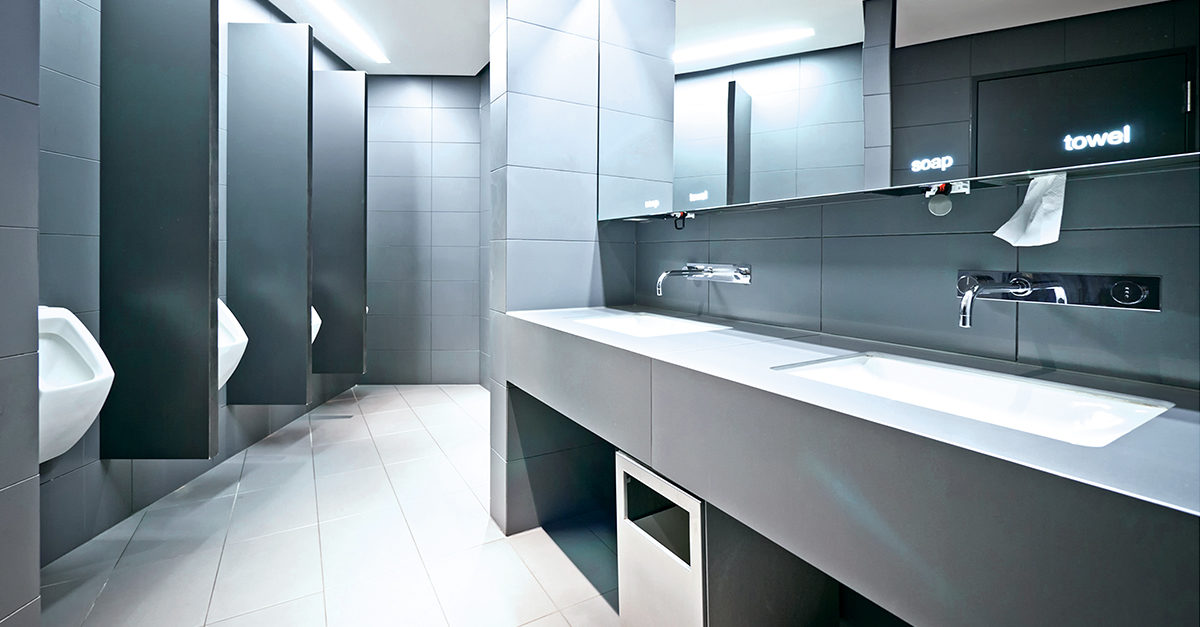In any commercial setting—whether it is a hotel, office, school, airplane or even a hospital—public restrooms represent one of the biggest infection prevention challenges and are areas with the greatest potential for germ cross-contamination. Due to their function and constant use, everything from urine and fecal matter to other bodily fluids and dirt contribute to restroom cleaning challenges daily. Not to mention, every time a toilet is flushed, it releases a plume of aerosolized droplets that can carry bacteria to other restroom surfaces like floors, walls, and handles,1 heightening cross-contamination concerns.
Cross-contamination occurs when bacteria and viruses are transferred from one surface to another. The abundance of high-touch surfaces and objects in public restrooms make it easy for patrons and even cleaning professionals to inadvertently move illness-causing pathogens from one surface to another. For example, when a woman’s purse is placed on a restroom floor and then placed on a sink counter, the germs and bacteria on the floor can be transferred to the purse and then to the sink. One study even found that 20 percent of handbags contained more germs than the average toilet flush and could potentially cross-contaminate other surfaces.2
While the potential for germ transmission and cross-contamination in restrooms is high, it may not always be top of mind for cleaning professionals, who often face conflicting priorities when it comes to restroom maintenance. This article outlines some tips for helping facility managers and cleaning professionals manage cross-contamination concerns in their facilities, especially during the winter months.
Making Sure Public Health Doesn’t Get Lost in Translation
Consumer perceptions of restroom cleanliness can have a serious impact on a business’ bottom line, but it’s always important to remember—and to stress to employees—that restroom cleanliness serves a critical public health function: preventing the spread of bacteria, viruses, and fungi that cause infection.
Cleaning issues typically associated with restroom appearance such as visible stains, soiled surfaces and odors can signal the presence of harmful microorganisms. Influenza (flu) and norovirus germs are commonly found in restrooms and are associated with outbreaks of illness.1,2 With flu season in full swing, cleaning to stop the spread of infections is especially important now, as the flu virus and other illness-causing germs can survive on surfaces for extended periods of time and can spread when people touch infected surfaces and then touch their eyes, mouth, or nose.
A recent survey3 of cleaning industry professionals conducted by the Clorox Professional Products Co. in partnership with ISSA, the worldwide cleaning industry association, found that most cleaning professionals (85 percent) are fully aware of the importance of cleaning for appearance and health and the majority (95 percent) believe that restroom cleaning has an impact on overall public health. However, only half of respondents (49 percent) believe that their staff is aware of all the risks associated with the spread of germs in the restroom. In fact, most survey respondents (68 percent) say their staff does not understand or only somewhat understands the differences between cleaning, sanitizing, and disinfecting. These distinctions are important and are as follows:4
- Cleaning removes germs, dirt, and impurities from surfaces or objects. Cleaning works by using soap (or detergent) and water to physically remove germs from surfaces, but does not necessarily kill them.
- Sanitizing lowers the number of germs on surfaces or objects to a safe level as judged by public health standards or requirements to lower the risk of spreading infection.
- Disinfecting kills germs on surfaces or objects using chemicals. The process does not necessarily clean dirty surfaces or remove germs, but killing germs on a surface after cleaning can further lower the risk of spreading infections.
Staff members should understand the role they play in preventing the spread of infection. Further, frontline cleaning professionals need the right products and appropriate training for the job.
Cleaning to Stop the Spread of Disease in the Restroom
Cleaning professionals can help prevent cross-contamination in restrooms by focusing cleaning and disinfecting efforts on germ-prone surfaces and objects such as countertops, urinals, toilets, door knobs, toilet handles, stall locks, and faucets. Since cleaning tools and equipment can become contaminated during the cleaning process, it is important not to clean multiple areas with the same supplies. Dirty cloths, sponges, and mops can spread viruses and bacteria to anything else they come in contact with, so it is important to regularly clean and disinfect or replace equipment as needed to avoid cross-contamination. Ready-to-use disposable disinfecting wipes can help decrease cross-contamination risks since they are designed to be thrown out after each use. Janitorial carts and closets should also be kept clean to prevent dirt and germs from traveling throughout a building on equipment.
Cleaning professionals should select disinfecting products that are specifically formulated and U.S. Environmental Protection Agency (EPA)-registered to kill illness-causing bacteria and viruses, such as influenza and norovirus, quickly. Remember that no matter which products are used, the best results are achieved when they are used correctly. Always refer to the product label and follow the manufacturer’s instructions for use and contact time, or the length of time the disinfectant needs to remain wet on the surface to properly kill viruses, fungi, and bacteria.
Finally, building occupants themselves also have a role to play in preventing cross-contamination, so it is important to encourage everyone to wash their hands regularly with soap and warm water—especially after sneezing or coughing, touching used tissues, or using the bathroom—and to stay home when they are sick to avoid spreading germs throughout the environment and to others.
Restrooms are one of the toughest jobs that cleaning professionals face in any industry or facility. However, with the right products, practices, and thorough cleaning and disinfecting, cleaning professionals can limit opportunities for cross-contamination and help ensure a healthy environment for building occupants and staff during flu season and year round.
1 Barker J, Jones MV. “The potential spread of infection caused by aerosol contamination of surfaces after flushing a domestic toilet.” Journal of Applied Microbiology. 99 (2005): 339–347.
2 Castillo, M. “Handbags may contain more germs than average toilet flush.” CBS News . (May 20, 2013). Web. Retrieved from: https://www.cbsnews.com/news/handbags-may-contain-more-germs-than-average-toilet-flush/.
3 Clorox Professional Products Co. and ISSA and ClearVoice Research. (May and June 2014). Cleaning Industry Professionals Public Restroom Survey. (Survey of 375 cleaning industry professionals).
4 NEA Health Information Network. “Cleaning, Sanitizing, and Targeted Disinfecting School Wide.” (2010). Web. Retrieved from: https://www.neahin.org/assets/pdfs/cleaning_school-wide_fs.pdf .




